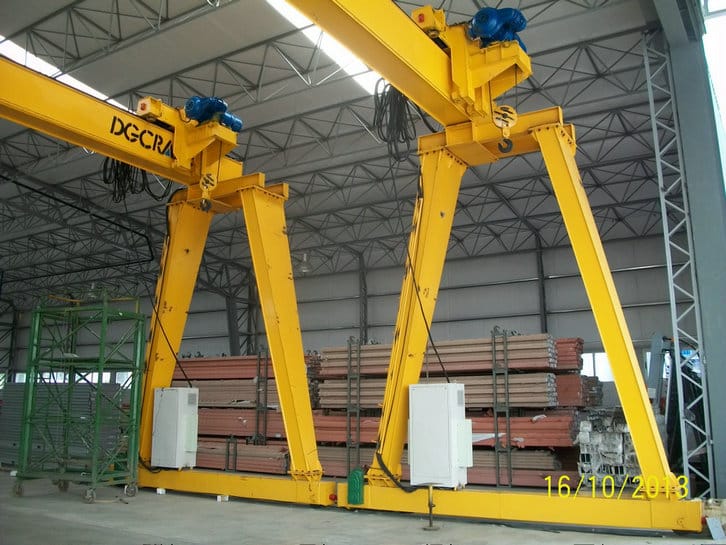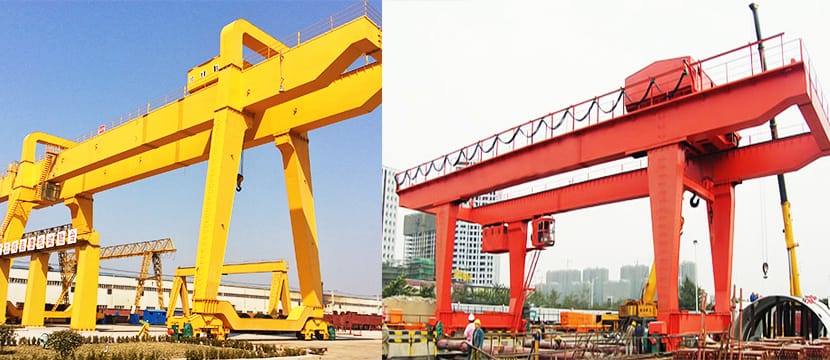Gantry cranes are excellent work horses for many industries and applications. This article focuses upon gantries in the ton to 5 tons category. Customers looking to buy gantry cranes need to know the answer to specific questions when making a purchase in order to size their crane correctly. This article addresses those questions.


The two keys areas of consideration are height and span and involve a number of elements.
Lowest Overhead Obstruction - what is the lowest object within your work area where the gantry crane will be used and/or moved? You must be sure that it can be erected and moved, if necessary, in and out of your work area and that it will fit underneath the lowest object directly overhead the workstation. The lowest overhead obstruction can be your ceiling, support beams, sprinklers, part of the HVAC system, pipes, railing, or many other things.
Overall Height: The overall height of the gantry crane normally includes the distance from the floor (including the casters) to the top of the I-Beam. If the crane is an adjustable height model with a range of 7'6" to 14'0" under I-Beam, the overall height, including the casters is that measurement (low to high) PLUS the height of the I-Beam.
Under Beam Height: The under beam height is measured from the floor to the bottom of the I-Beam. Again, subtracting the height of the I-Beam from the overall height will equal the under I-Beam height.
Hook Height Requirement: This is probably the most critical item in terms of height requirements. It refers to the measurement from the floor to the inside of the bottom hook on the hoist at the highest point your workload needs to be lifted as it is secured to the hook. Make certain you consider any slack in a chain or a sling, etc. that you will use to lift your load.
Head Room: Trolleys and hoists differ in size and height. If overall height restrictions are tight you may need to shop around for a trolley/hoist combination that will come within your "headroom" requirements. The combined height of the trolley and the hoist down to the inside of the hoist's bottom hook is called "headroom." Headroom will be measured from the bottom of the rollers on the trolley to the inside part of the bottom hook on the hoist (when attached to the trolley). If you need to be exact, add the thickness of the flange on the I-Beam where the trolley rollers sit. If you are trying to minimize headroom, look for a "lug mounted" trolley/hoist unit. This type of trolley and hoist are mounted to one another which reduces the headroom they will take up in your gantry configuration.
Chain Fall: Hoists come in a variety of chain length options. The chain fall is the amount of chain available for lifting. If you have a 15' chain fall, then there is 15' of usable chain from the hoist to the hook when fully extended. Keep in mind your head room measurements as well as any need to go below grade in determining your chain fall requirements. For example, let's say you have a 10' hook height requirement with 2'6" of headroom required for your trolley and hoist. First, the gantry crane should meet or exceed 12'6" under I-beam height (10' hook height + 2'6" head room). If we choose a standard crane with 14' under I-Beam, how much chain fall is required to reach a hook point 2' above the floor? Answer: 14'minus 2'6" head room equals an 11'6" hook height (which exceeds your 10' hook height requirement). Therefore you have an 11'6" maximum hook height minus 2' which equals 9'6" of chain fall required to reach a load 2' above the floor. Given popular options you may want to go with a 10' chain fall. So even though the under I-beam height is 14', you only need a standard length 10' chain fall to reach a hook point 2' above the floor.
Height Adjustments: For adjustable height models, you may want to consider a height adjustment kit to make height adjustment of the beam easier. Beams can be very heavy on steel models and roughly about 1/3 of the overall weight of the crane. For easier height adjustment consider an aluminum crane which will be less than ? of the overall weight of a steel crane, although more expensive.
There are two measurements to note on the span or width of your gantry crane. The first is the overall width which is simply outside edge to outside edge of the beam and legs. Gantries have end stops to keep the trolley from rolling off the beam and/or base plates (used to mount the legs and beam together versus welding). This means the trolley does not roll the full length of the beam and this must be considered in determining the width of the beam you require. The "usable width" measures the distance between the end points where the trolley will stop on either side. Usable width will be in the neighborhood of 2'6" less than the overall width of the beam.
Capacity: Be certain that your hoist capacity does not exceed the capacity of your crane or trolley. Ideally, the capacity of the crane, trolley and hoist are the same. From the top down, your crane should equal or exceed the capacity of your trolley and your trolley should equal or exceed the capacity of your hoist. All components of your gantry system should equal or exceed the weight of your maximum load. - but not by too much. Choose a capacity closest to your load that will get the job done. Cranes are typically tested at 125% of the rated capacity so there is no need for over kill.
Armed with this knowledge, you are now ready to shop for your gantry crane.
Wire Rope Care and Maintenance: A Comprehensive Guide in Six Stages
Copyright@Henan Suitong Machinery Co., LTD. All rights reserved.